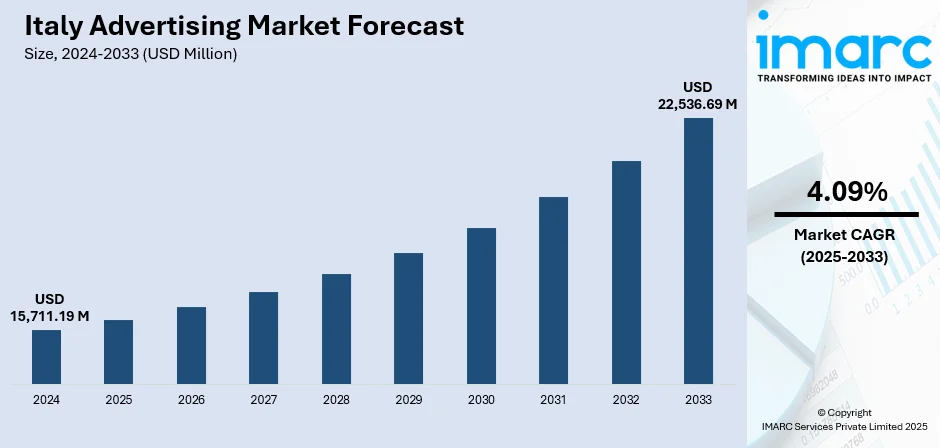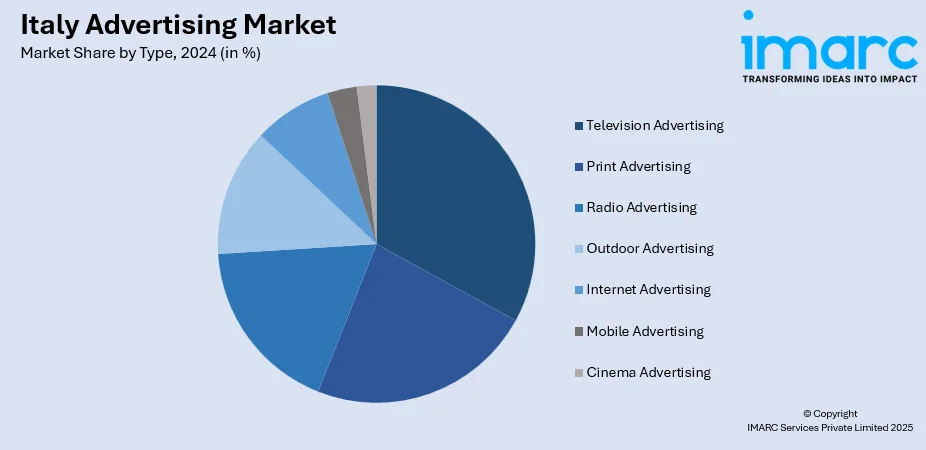
Italy Advertising Market Size, Share, Trends and Forecast by Type and Region, 2025-2033
Italy Advertising Market Overview:
The Italy advertising market size reached USD 15,711.19 Million in 2024. The market is projected to reach USD 22,536.69 Million by 2033, exhibiting a growth rate (CAGR) of 4.09% during 2025-2033. The market is adapting to shifts in consumer behavior, digital transformation, and evolving media landscapes. Traditional media like TV and print are still on the roster, digital media particularly social media, mobile, and programmatic ads are becoming increasingly important. Brands are spending money on tailored content and targeted campaigns to target audiences better. Local variation in media usage also shapes strategy. As advertisers adopt innovation and data-driven strategies, these changes go on to define the competitive dynamics of the Italy advertising market share.
|
Report Attribute
|
Key Statistics
|
|---|---|
|
Base Year
|
2024
|
|
Forecast Years
|
2025-2033
|
|
Historical Years
|
2019-2024
|
| Market Size in 2024 | USD 15,711.19 Million |
| Market Forecast in 2033 | USD 22,536.69 Million |
| Market Growth Rate 2025-2033 | 4.09% |
Italy Advertising Market Trends:
Digital Penetration Surpasses Traditional Media
In September 2024, Italy’s advertising industry entered a clear turning point as digital media officially overtook traditional formats in share of spend. This change reflects a broader shift in audience behavior Italians are consuming content primarily through mobile devices, streaming platforms, and online news outlets. As a result, advertisers are shifting strategies to emphasize interactive formats like programmatic video, social display, and influencer-integrated content. While traditional media such as television and print retain some reach, especially among older audiences, their dominance is steadily declining. Marketers are increasingly investing in tools that offer real-time data, segmentation, and measurable performance. This transition is also reshaping how campaigns are planned shifting from static timelines to agile, always-on execution. With user attention fragmenting across channels, a digital-first approach allows brands to stay relevant, flexible, and efficient in their communication strategies. The rise in digital share is not just a trend it’s an inflection point that reflects both global influence and local media evolution. This shift firmly signals Italy advertising market growth driven by deeper digital engagement.

To get more information on this market, Request Sample
Stricter Rules Shape Influencer Marketing
In January 2024, Italy’s Communications Authority introduced new regulations targeting influencer advertising, reflecting a push for greater transparency in digital marketing. These rules require influencers with large audiences to clearly label paid promotions with hashtags like #adv or #sponsored and disclose any form of compensation. The regulations aim to protect consumers from misleading content, especially younger viewers, by banning subliminal messages and mandating honesty in endorsements. Fines for violations range from €10,000 to €600,000, signaling the government’s commitment to enforcing accountability. This regulatory update follows a notable rise in influencer-driven campaigns, which have become key tools for brands to connect with target demographics online. Marketers and creators are adapting strategies to comply with these guidelines, emphasizing ethical promotion and transparent communication. This development aligns with global efforts to formalize digital advertising practices while boosting consumer trust. As the ecosystem evolves, these changes will play an essential role in defining the future of social media marketing. Such regulatory focus is a vital aspect of ongoing Italy advertising market trends.
Emerging Influence of Digital Tax Policy on Advertising
In October 2024, Italy announced a broadening of its digital services tax framework, signaling increased fiscal oversight of online advertising. The expanded tax extends beyond large digital platforms to cover a wider range of businesses generating ad revenue through digital interfaces, raising legal obligations for advertisers and platforms alike. This shift reflects a broader governmental focus on digital monetization and its economic impact. Advertisers operating within Italy must now account for these evolving tax structures when planning campaigns and budgeting spend across digital channels. The change introduces new compliance layers, as platforms may now need to register for tax purposes and report detailed financial data, which could influence pricing and operational structures. As this policy environment tightens, businesses are reviewing contractual and financial mechanisms to ensure alignment. The adjustment also implies a more regulated fiscal landscape that directly intersects with advertising activity, especially on large-scale digital platforms. This regulatory development may influence strategic decisions around where and how advertisers allocate budgets.
Italy Advertising Market Segmentation:
IMARC Group provides an analysis of the key trends in each segment of the market, along with forecasts at the country and regional levels for 2025-2033. Our report has categorized the market based on type.
Type Insights:

- Television Advertising
- Print Advertising
- Newspaper Advertising
- Magazine Advertising
- Radio Advertising
- Outdoor Advertising
- Internet Advertising
- Search Advertising
- Display Advertising
- Classified Advertising
- Video Advertising
- Mobile Advertising
- Cinema Advertising
The report has provided a detailed breakup and analysis of the market based on the type. This includes television advertising, print advertising (newspaper advertising and magazine advertising), radio advertising, outdoor advertising, internet advertising (search advertising, display advertising, classified advertising, and video advertising), mobile advertising, and cinema advertising.
Regional Insights:
- Northwest
- Northeast
- Central
- South
- Others
The report has also provided a comprehensive analysis of all the major regional markets, which include Northwest, Northeast, Central, South, and others
Competitive Landscape:
The market research report has also provided a comprehensive analysis of the competitive landscape. Competitive analysis such as market structure, key player positioning, top winning strategies, competitive dashboard, and company evaluation quadrant has been covered in the report. Also, detailed profiles of all major companies have been provided.
Italy Advertising Market News:
- June 2025: Zappi and VaynerMedia have unveiled their latest State of Creative Effectiveness report, offering fresh insights into the evolving power of advertising creativity. Based on a large-scale consumer testing initiative using Zappi’s Amplify system, the report explores the isolated impact of creative work on campaign outcomes, highlighting trends around emotion, storytelling, celebrity influencers, and AI-enhanced approaches. With emphasis on strategic iteration and audience-centric design, the findings provide a roadmap for brands seeking more effective and memorable advertising.
Italy Advertising Market Report Coverage:
| Report Features | Details |
|---|---|
| Base Year of the Analysis | 2024 |
| Historical Period | 2019-2024 |
| Forecast Period | 2025-2033 |
| Units | Million USD |
| Scope of the Report |
Exploration of Historical Trends and Market Outlook, Industry Catalysts and Challenges, Segment-Wise Historical and Future Market Assessment:
|
| Types Covered |
|
| Regions Covered | Northwest, Northeast, Central, South, Others |
| Customization Scope | 10% Free Customization |
| Post-Sale Analyst Support | 10-12 Weeks |
| Delivery Format | PDF and Excel through Email (We can also provide the editable version of the report in PPT/Word format on special request) |
Key Questions Answered in This Report:
- How has the Italy advertising market performed so far and how will it perform in the coming years?
- What is the breakup of the Italy advertising market on the basis of type?
- What is the breakup of the Italy advertising market on the basis of region?
- What are the various stages in the value chain of the Italy advertising market?
- What are the key driving factors and challenges in the Italy advertising market?
- What is the structure of the Italy advertising market and who are the key players?
- What is the degree of competition in the Italy advertising market?
Key Benefits for Stakeholders:
- IMARC’s industry report offers a comprehensive quantitative analysis of various market segments, historical and current market trends, market forecasts, and dynamics of the Italy advertising market from 2019-2033.
- The research report provides the latest information on the market drivers, challenges, and opportunities in the Italy advertising market.
- Porter's five forces analysis assists stakeholders in assessing the impact of new entrants, competitive rivalry, supplier power, buyer power, and the threat of substitution. It helps stakeholders to analyze the level of competition within the Italy advertising industry and its attractiveness.
- Competitive landscape allows stakeholders to understand their competitive environment and provides an insight into the current positions of key players in the market.
Need more help?
- Speak to our experienced analysts for insights on the current market scenarios.
- Include additional segments and countries to customize the report as per your requirement.
- Gain an unparalleled competitive advantage in your domain by understanding how to utilize the report and positively impacting your operations and revenue.
- For further assistance, please connect with our analysts.
 Request Customization
Request Customization
 Speak to an Analyst
Speak to an Analyst
 Request Brochure
Request Brochure
 Inquire Before Buying
Inquire Before Buying




.webp)




.webp)












